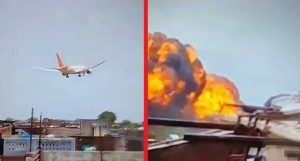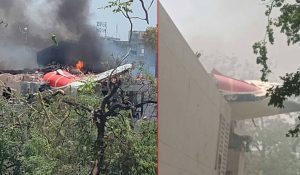Table of Contents
ToggleHow could a routine international flight turn into a national tragedy within moments? Why did a modern aircraft, designed for long-haul travel, fail so catastrophically so soon after takeoff?
These are the urgent questions being asked after Air India Flight AI171, a London-bound Boeing 787-8 Dreamliner, crashed into a residential neighbourhood shortly after departing from Sardar Vallabhbhai Patel International Airport (SVPIA), Ahmedabad, on Thursday, 12 June 2025.
The flight, bound for London Gatwick, was carrying 242 people, including 232 passengers and 10 crew members. Tragically, just one minute into its journey, the aircraft lost altitude and crashed into the Meghaninagar locality, sending shockwaves across India and the United Kingdom.
What Do We Know About the Aircraft and Crew?

Image – Source
The aircraft involved in the crash was a Boeing 787-8 Dreamliner, one of the flagship models used by airlines for long-distance routes due to its fuel efficiency and advanced avionics. The aircraft was reportedly fully fuelled for the intercontinental flight, which added to the severity of the impact upon crashing.
At the controls were Captain Sumit Sabharwal, a highly experienced pilot with 8,200 flying hours, and First Officer Clive Kunder, with 1,100 flying hours. Both were qualified for international operations, and their records, as per DGCA, were clear of any prior incidents or disciplinary actions.
The flight was scheduled to take off at 13:38 IST and had barely begun its climb when it encountered a major technical fault. The ATC (Air Traffic Control) confirmed that the aircraft issued a MAYDAY call moments after liftoff. However, all communication was lost shortly thereafter.
Where and How Did the Crash Occur?
Shortly after becoming airborne from Runway 23, the aircraft failed to gain sufficient altitude. According to Flightradar24, the Dreamliner reached just 825 feet before descending rapidly at 475 feet per minute. Within moments, it slammed into a densely populated section of Meghaninagar, a suburb of Ahmedabad.
Eyewitnesses described scenes of chaos, with the aircraft descending alarmingly low over rooftops, followed by a deafening explosion. Heavy black smoke rose from the crash site and could be seen from multiple locations across the city. The aircraft caught fire almost instantly after impact due to the full fuel load, creating a hazardous situation for both passengers and people on the ground.
Several buildings in the crash path sustained significant damage, and emergency services reported multiple casualties, though the exact toll remains unconfirmed as search operations continue.
How Did Emergency Services Respond to the Ahmedabad Crash?
Emergency response was both rapid and large-scale. Within minutes of the crash, over two dozen ambulances, fire tenders, and police units reached the scene. The roads in and around Dharpur and Meghaninagar were immediately closed off as authorities initiated containment and rescue operations.
Hospitals in Ahmedabad were put on high alert, and several injured passengers and residents were taken for urgent treatment. Makeshift triage zones were established on-site to prioritise medical care.
The SVPIA airport suspended all operations, diverting incoming flights and cancelling outbound services until further notice. An emergency coordination centre was activated by Air India to facilitate communication between authorities, rescue teams, and the families of passengers.
What Has Been the Official Response from Authorities?
The Directorate General of Civil Aviation (DGCA) quickly confirmed the crash and initiated a full-fledged investigation. The flight’s black box and cockpit voice recorder have been recovered and sent for analysis, which will help determine the mechanical and operational events leading to the crash.
Union Home Minister Amit Shah contacted Gujarat Chief Minister Bhupendra Patel to ensure all resources were deployed to manage the crisis. Civil Aviation Minister K Ram Mohan Naidu announced he was personally overseeing the situation and had instructed all aviation and emergency agencies to act in coordinated fashion.
Prime Minister Narendra Modi expressed shock and instructed both ministers to visit the crash site, provide all necessary support, and assist the families affected. Government agencies are working with Air India and local officials to ensure survivors receive medical care and that families are updated on the evolving situation.
How Has Air India Addressed the Tragedy?

Image – Source
Air India released multiple statements across platforms, confirming the involvement of Flight AI171 in the crash. The airline acknowledged that the plane was carrying 169 Indian nationals, 53 British citizens, one Canadian, and seven Portuguese nationals.
Chairman N Chandrasekaran described the incident as a “tragic accident,” offering heartfelt condolences to those affected. Air India has since activated support teams to help with emergency communication, logistical assistance, and grief counselling for families of passengers.
An information desk has been set up at Ahmedabad airport, and updates are being issued via the airline’s website and official X (formerly Twitter) handle.
What Are the Possible Causes Behind the Crash?
Though the final cause will be determined by the ongoing DGCA investigation, aviation experts are already analysing preliminary data. According to early reports, the aircraft’s inability to gain altitude points to a possible mechanical or hydraulic failure.
Expert Sanjay Lazar noted the unusually low climb rate and sudden descent as signs of a catastrophic lift issue, potentially exacerbated by a malfunctioning autopilot system, a failure in engine thrust output, or flight control system breakdown.
Considering the aircraft was carrying fuel for a long-haul flight, the crash resulted in a massive fire, complicating both rescue operations and aircraft forensic analysis. Weather conditions were reported as clear, which largely rules out environmental interference.
What Is the Timeline of the Crash and Response?
To understand the sequence of events, the table below outlines the timeline of Flight AI171’s final moments and emergency actions:
| Time (IST) | Event Description |
| 13:38 | Aircraft takes off from Runway 23 at Ahmedabad Airport |
| 13:39 | MAYDAY call issued to Air Traffic Control |
| 13:40 | Aircraft loses altitude and crashes into Meghaninagar |
| 13:41 | Smoke and explosion observed at crash site |
| 13:45 | Emergency response teams arrive on scene |
| 14:10 | Flight operations at SVPIA suspended |
| 15:30 | Air India issues formal confirmation of crash |
| 16:00 | DGCA confirms start of full investigation |
How Has the Crash Impacted the UK and International Community?
With 53 British nationals on board, the crash immediately drew attention from the UK government and international media. The British High Commission in India confirmed it is working with Indian authorities to provide assistance to UK families.
British media outlets, including BBC News, Sky News, and The Guardian, have been closely following developments. The incident has prompted the UK Civil Aviation Authority to initiate consultations with Indian regulators regarding flight safety standards and coordination for international routes.
The crash is also expected to affect short-term passenger confidence in routes between India and the UK, especially on flights operated by state-run carriers.
FAQs on Ahmedabad Plane Crash
What caused Air India Flight AI171 to crash?
The exact cause is under investigation, but early reports point to a mechanical failure during takeoff, possibly related to the aircraft’s lift or thrust systems.
Were there any survivors in the Ahmedabad plane crash?
Rescue operations are ongoing. While several injured individuals have been taken to hospital, the total number of survivors and fatalities is yet to be officially confirmed.
Where did the aircraft crash?
The plane crashed near Meghaninagar in Ahmedabad, just beyond the airport perimeter, in a residential area.
What was the aircraft model involved in the crash?
The aircraft was a Boeing 787-8 Dreamliner, one of Air India’s long-haul fleet aircraft used for international routes.
What steps is the DGCA taking after the crash?
The DGCA has launched a comprehensive investigation, grounded the aircraft model involved for inspections, and is analysing the flight and cockpit data recorders.
What is the UK’s involvement in the incident?
With 53 British citizens on board, the UK is coordinating with Indian authorities via its High Commission in New Delhi to assist families and monitor the investigation.
Will this crash affect flights between India and the UK?
In the short term, yes. Flights may be delayed or suspended for safety checks. Long-term impact will depend on the findings of the investigation and regulatory response.




